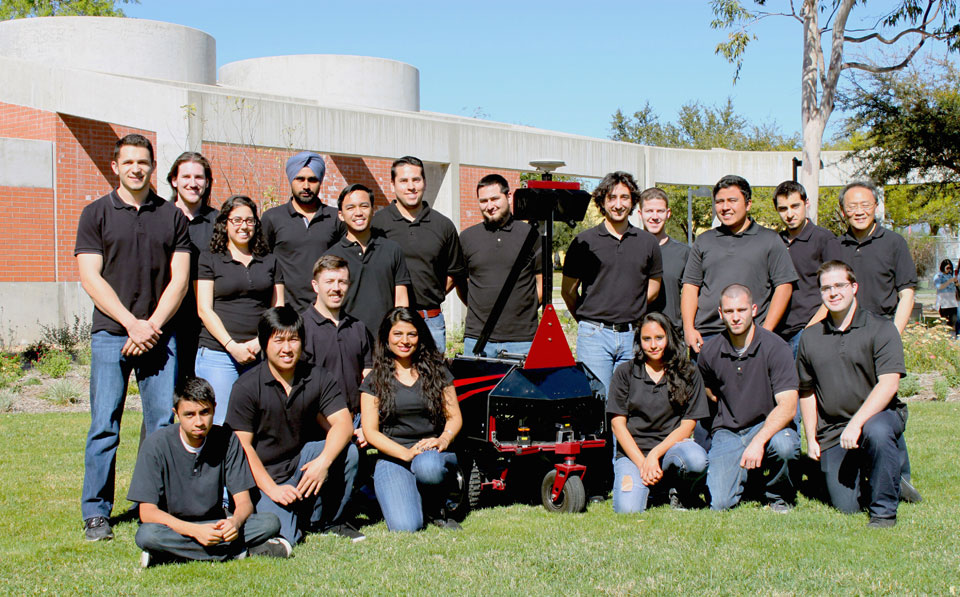CSUN Engineering Students ‘Bull’ Their Way to a Championship

CSUN's champion Intelligent Ground Vehicle team with El Toro. From Top Left: Gavin Fallen, Steven Moro, Melody Mojib, Jangjujhar Singh, Philip Fadriquela, Luis Garcia, Misael Toledo, Adrian Inghilterra, Benjamin Davis, Sam Gaxiola, Naimat Shifa, Prof. C.T. Lin. From Bottom Left: Bryan Juarez, Sidney Lim, Michael Gaunt, Manpreet Sidhu, Karen Guerrero, Jeff Sutherland, Erik Wagner. Photo courtesy of C.T. Lin.
Erik Wagner held his breath as El Toro entered the outdoor obstacle course. A California State University, Northridge mechanical engineering senior, Wagner and 17 other students were representing CSUN at the 23rd annual Intelligent Ground Vehicle Competition (IGVC) held at Michigan’s Oakland University earlier this month.
They nervously waited for El Toro — an autonomous robot that the team built from scratch for more than two semesters, and named for its bulky body, laser range finder mounts and its CSUN pride — to round its first turn. So many things could happen — Would it veer off course? Would it do everything that they programmed so tirelessly?
Then, without a hitch, El Toro successfully turned and went on to perfectly navigate hills and ramps, correctly identifying colors and lines on the ground, and took first in the overall competition.

Mechanical engineering senior, Erik Wagner, holds the first place trophy at the 2015 International Ground Vehicle Competition at Oakland University in Michigan. Photo courtesy of C.T. Lin
“It was pretty incredible,” said Wagner, student project manager for the team. “You don’t know what your robot will think at times. We saw many teams who would start their robot, but it would turn off of the course, even though generally it worked. Once you see it do that first turn, you are hoping that means everything is working like you hoped. It’s very nerve-racking.”
To win the overall title, the robot had to master a basic course, an advanced course, vehicle design, and the portion for Joint Architecture for Unmanned Systems (JAUS). The JAUS competition requires a vehicle to meet the JAUS standards by receiving and responding wirelessly to a list of commands to and from the judges. Though CSUN placed second for the basic and advanced courses, behind the University of New South Wales’ team, El Toro won the JAUS competition by a landslide, contributing to CSUN’s overall win.
CSUN has competed in the IGVC since 2006, and took home the first-place title in 2011, again in 2012, and placed second subsequently until this year. The team was comprised mostly of mechanical engineering and some electrical engineering students who choose the unmanned vehicle project for their senior capstone.
Mechanical engineering professor C. T. Lin, who has advised the project since it first formed in 2005, said the project is unique because of its unmanned nature. The students working on this project are required to explore and develop cutting-edge autonomous technology.
“With this type of technology, a lot of real-time decision making has to be on board,” Lin said. “All these unmanned vehicles require intelligence, without it there’s no decision making. The intelligence on board has to cope with the constantly changing environments and conditions as the vehicle is operating. That would require intelligence to be developed in the software… [it] is what really makes this project different.”
Lin also noted that with three women on the team, CSUN’s team represented the most female students of any school in the entire competition.
Wagner was excited to be part of such a current trend in technological innovation. “One of the unique things about this opportunity is that autonomous navigation is something that still hasn’t developed fully, so it was an interesting experience to be solving a problem that hasn’t been solved already,” Wagner said.
To build such an advanced vehicle requires a lot of elbow grease, but also necessitates significant financial investment. According to Lin, El Toro is worth about $25,000 in laser sensors, a GPS navigation system, cameras and drive trains of the robot, although some of the parts are reusable. The project is financed by funding from the CSUN instructionally related activities committee and is sponsored by both the mechanical engineering and electrical engineering departments. The team won a total of $9,000 from the competition.
Lin said that students gain tremendous skills from this project due to its multidisciplinary nature involving physics, computer programming, and electrical and mechanical engineering. To build the robot, the team split into six groups, specializing in vision, cognition, navigation, power, mechanical design and JAUS. The year-long effort emphasized how to effectively work as a team.
“If the mechanical design team wanted to use a certain type of structural material or add another mechanical component, what happens is that you increase the weight. As a result, the battery capacity would need to be increased because the charged life of battery would run shorter,” Lin said. “This example shows that they have to have a constant dialogue. One team cannot just change the design without notifying the other teams.”
Lin said the College of Engineering and Computer Science provides hands-on training, so the students are very prepared for their professional careers.
“Employers often mention that CSUN students are ready on day one because of this training and experience,” Lin said.
Wagner said he enjoyed the individual freedom that the IGVC project allowed because it was more like the reality in the field.
“In the workforce… you don’t have somebody on you all the time, you’re just given a task that you are expected to complete,” Wagner said. “Nobody’s going to come and babysit you along the way, you just have to know to do your work.”

 experience
experience